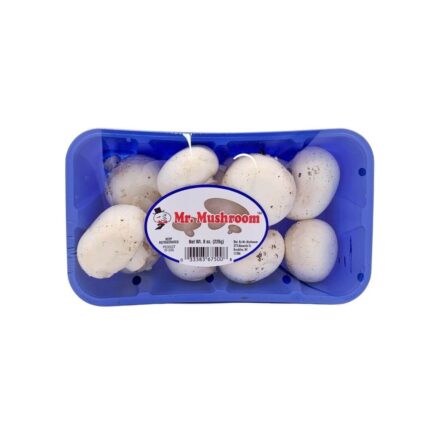3 – 5 lbs
Oyster Mushroom aka “Pearl Oyster Mushroom”, “Hiratake”, “Hao-Gu”, “Ping-Gu”, “Xiu-Zhen-Gu”, “蠔菇”, “平菇”, “秀珍菇”
Oyster mushroom has a light to a dark brown, funnel-shaped cap, with whitish-yellow veils running up a short off-center stem. The flesh is white and it grows in a shelf-like formation often with overlapping clusters. The flavor is delicate and savory, with a subtle anise finish. Oyster mushroom is best eaten fried or sautéed. This mushroom variety may be used raw or cooked. Oyster mushroom is available year-round.
Handling Tip
Selection
Oyster mushroom has a uniform color with no signs of wilting, brown spots, or sliminess.
The oyster mushroom veil is fully intact. The open veil is not a sign of poor quality but will shorten shelf life.
Storage
Oyster mushrooms should be stored at 36°F – 38°F (2°C – 3°C) with a relative humidity of eighty-five to ninety percent and no mist.
The typical shelf life is seven to ten days. The high relative humidity is essential to prevent stipe blackening and veil opening.
Oyster mushroom is sensitive to odor and should not be stored with strong aroma products. Especially, green onions should not be stored or displayed with oyster mushrooms.
The oyster mushroom is sensitive to water. Oyster mushroom cartons should be kept off the wet floor. If wet, they will develop wrinkles, brown spots, or deteriorate prematurely.
Oyster mushroom is sensitive to ethylene, a naturally occurring gas regulating ripening. Oyster mushrooms should not be stored with high ethylene-producing products to extend shelf life. Oyster mushroom produces a low level of ethylene.
Oyster mushroom is not sensitive to chilling injury but is sensitive to freezing injury. The freezing point for oyster mushrooms is 31°F (-0.6°C). Freezing injury symptoms include water-soaked and extremely soft caps.
Creating clear and transparent shipping and handling policies is crucial for a commodity trading company like Agropastoral Products Co., Ltd. Here's a framework for the Shipping and Handling Policy:
1. Shipping Policy:
a. Shipping Process: - Detail the steps involved in the shipping process, from order placement to delivery.
b. Shipping Rates: - Specify the shipping costs associated with various products or order amounts.
c. Delivery Timeframe: - Provide estimated delivery times based on location and shipping method.
d. Shipping Carriers: - Name the shipping carriers used and any partnerships that may influence shipping.
e. International Shipping: - Explain international shipping options, rates, and potential customs or import duties.
f. Tracking Information: - Describe how customers can track their orders and obtain tracking information.
g. Shipping Restrictions: - List any countries, regions, or products where shipping may be restricted or limited.
2. Handling Policy:
a. Packaging: - Describe how products are packaged to ensure safe transit and delivery.
b. Quality Assurance: - Explain any quality control measures or checks in place during the handling process.
c. Fragile Items: - Provide special handling instructions for fragile or delicate commodities.
d. Inventory Management: - Detail how inventory is managed to maintain accuracy and prevent errors in order fulfillment.
e. Returns and Exchanges: - Outline the process for handling returns, exchanges, or replacements related to shipping issues or damaged items.
3. Additional Policies:
a. Lost or Damaged Items: - Explain the procedure for reporting and addressing lost or damaged items during shipping.
b. Split Shipments: - Describe under what circumstances the company may split an order into multiple shipments and how this is communicated to the customer.
c. Free Shipping Offers: - Clarify conditions for free shipping, such as minimum order amounts or specific products.
d. Holiday or Peak Season Shipping: - Provide information about any special considerations or delays during peak seasons or holidays.
e. Force Majeure: - Address how the company handles unforeseen events like natural disasters, strikes, or other force majeure events affecting shipping and delivery.
f. Contact Information: - Provide contact details for customers to reach out for shipping-related queries, concerns, or support.
Regularly update and review these policies to ensure they align with your company's operations and any changes in shipping or handling processes. Communicating these policies clearly to your customers will help manage their expectations and provide a positive shopping experience.












Reviews
There are no reviews yet.